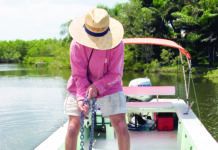Every onboard first-aid kit should have medication to treat seasick crew. Practical Sailor magazine surveyed sailors about the over-the-counter and prescription drugs they use to treat the nausea, vomiting, and other maladies associated with seasickness and motion sickness. Our review looked at the nine antiemetic medications mentioned in the survey responses, including five typically classified as antihistamines and four prescription drugs. Those sailors surveyed described the effectiveness, dosages, and side effects of seasickness medications. Antihistamines discussed in the survey include Meclizine (sold as Bonine and non-drowsy Dramamine II in the U.S. and SeaLegs in the UK), Dramamine, Marezine, Phenegran, and Stugeron. The prescription seasickness drugs detailed were two scopolamine-based medications: Scopace and Transderm Scopolamine (known as the Patch or the Travel Patch).
****
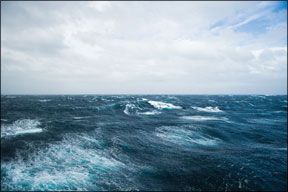
Photo by Alexander Hafeman
Few things we do as sailors are as undignified or humbling as hanging upside down over the side of the boat and “feeding the fish.” But our love of sailing keeps us searching for a remedy that will restore our dignity and expunge those few unhappy hours from our time on the water.
For shorthanded offshore crews, the need for an effective seasickness medicine is a necessity. Crews tend to be most susceptible to seasickness at the most dangerous times: at the start of a passage in inshore waters where other traffic and tricky navigation pose real hazards. A crewmember debilitated by seasickness can put the vessel and others at risk.
Unfortunately, seasickness meds do not lend themselves to our normal testing procedures. Conditions that lead to mal de mer differ from person to person, as do the symptoms, degree of debilitation, and the usefulness and side effects of any given therapy or medication. Some treatments can exacerbate conditions like hypertension, heart disease, or depression. These variations make it impossible to come up with a one-size-fits-all recommendation for a remedy.
In our last in-depth look at seasickness drugs (Practical Sailor, Nov. 15, 2001), one tester prone to motion sickness tested various medications while valiantly riding along bumpy roads in the back seat of car. He got good results from the Davis Queaz-Away acupressure bands, Discoverer Relief electrical stimulation band, and Dramamine (dimenhydrinate).
This time, we focused on prescription and over-the-counter drugs. Instead of a single tester, we surveyed a group of experienced offshore sailors. See “How We Tested.”
WHAT WE EVALUATED
We were interested in any over-the-counter or prescription antiemetic used to treat motion sickness. Nine medications were mentioned by the 37 sailors we surveyed, including five typically classified as antihistamines and four prescription drugs. Of the nine medications, seven had been used regularly by at least one respondent. The table on page 28 summarizes their dosages, side effects, and effectiveness. Three important points need to be made with respect to this table.
Drug names: The same drug may be sold under a variety of names worldwide. In the table, the drugs are listed under the most common brand name in the US, Canada, and Mexico; other North American brand names we are aware of are shown. Only by knowing the generic name can you be certain of what drug you are getting when you purchase an antiemetic in another country.
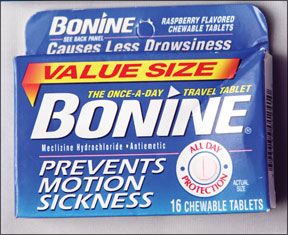
Photos by Beth Leonard
Dosages: Some of these drugs are used in higher dosages for purposes other than motion sickness, most commonly to control vertigo and nausea and vomiting from anesthetics or chemotherapy. The dosages listed in the table are those recommended for motion sickness.
Side effects: The side effects shown are those most commonly experienced and do not include the potentially severe side effects that are reported as being “rare.”
All of these drugs have warnings about allergic reactions. Stop taking any medication immediately if you experience difficulty breathing, closing of your throat, hives, or the swelling of your lips, tongue, or face.
The table on page 29 provides an overview of some of the contra-indications, potential drug interactions, and complications that can occur with each drug. Seek your doctors advice before using these drugs. Always be sure to thoroughly read any warnings, side effects lists, and instructions on a drugs label.
Drug-free and natural remedies will be reported on in a future issue.
ANTIHISTAMINES
The majority of drugs regularly used to treat seasickness are classed as antihistamines. Their side effects tend to be significantly milder than other antiemetics, and many can be purchased without a prescription. These drugs block histamine receptors and receptors for the neurotransmitter acetylcholine, which activates muscles. Though the anticholinergic effect varies from drug to drug, this shared pharmacology accounts for the drugs similar side effects and potential impact on conditions like asthma and glaucoma. Exactly how some antihistamines relieve nausea is not known, but they do affect receptors in the central nervous system and in the smooth muscles in the digestive tract.
BONINE
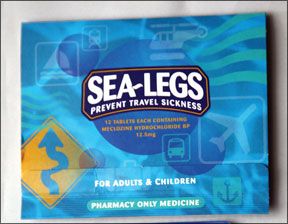
Most people in the US know it as Bonine or Dramamine II (the non-drowsy formula), but its generic name is meclizine, and 39 percent of our survey respondents who used medication had tried it. Sold over the counter, Bonine is marketed as having fewer side effects than Dramamine. Our survey results support this claim: 46 percent of respondents who had tried it, experienced side effects compared to 83 percent who used Dramamine.
The reported side effects were also less severe. This corresponds with the medical literature, which reported no serious side effects. However, as a seasickness remedy, Bonine was ineffective for 27 percent of our respondents. The Committee to Advise on Tropical Medicine and Travel (CATMAT) study said that it “does not appear as effective as the scopolamine patch.” (See table, page 27.)
Most respondents who had tried it preferred other medications that were more effective or did not make them drowsy. Bonine was the drug of choice for about 10 percent of the total respondents, who found other medications left them feeling drugged and unable to function.
Bottom line: The lack of any serious side effects makes this the drug of choice for those who find it an effective treatment.
DRAMAMINE
“Considered one of the treatments of choice,” according to the CATMAT study, the active ingredient in Dramamine is dimenhydrinate. It can be bought without a prescription.
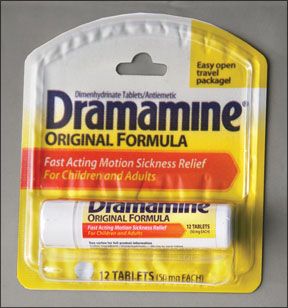
Our respondents did not agree with the studys assessment: Forty-three percent had tried it, and one-third of those found it ineffective. None preferred it or recommended it to others. More than 80 percent of those who tried it reported experiencing moderate to extreme drowsiness-to the point that it was nearly impossible to stay awake on watch.
A National Center for Biotechnology Information study we came across-www.ncbi.nlm.nih.gov/pubmed/9327113-even suggested that Dramamines antiemetic properties may be a function of its sedative effects.
Bottom line: Extreme drowsiness is fine in the back seat of a car or on a plane, but not on watch.
MAREZINE
While chemically similar, cyclizine (the active ingredient in Marezine) and meclizine (Bonine) were rated differently in our survey and in several studies we read. Unlike Bonine or Dramamine, Marezine is not stocked in most US drug stores, but it often can be special-ordered without a prescription.
Only four of our respondents had tried Marezine, but all of them found it to be effective. Three of the four experienced mild side effects that caused no impairment or discomfort. Two preferred it over other drugs; a third preferred Stugeron because it could be taken at eight-hour intervals instead of four-hour intervals; and the fourth preferred not to use medication. Three of the four said they would recommend it to others.
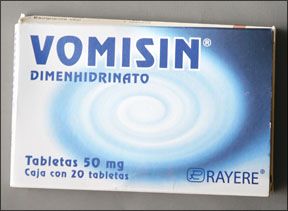
In one study, Marezine was shown to be twice as effective as Bonine and similar to Stugeron (www.motionsickness.net/16article.html) with risks and side effects similar to Bonine. (See tables, pages 28-29.)
Bottom line: The small size of the test group prevents us from drawing any firm conclusions here. However, Marezine appears to combine the efficacy of Stugeron with the safety of Bonine, an attractive combination.
PHENERGAN
Phenergan is marketed as an antihistamine, a sedative, and an antiemetic, but promethazine, its active ingredient, is in the same class of drugs as anti-psychotics like Thorazine.
Phenergans common side effects are similar to other antihistamines, but a partial list of drugs Phenergan interacts with include six major classes of drugs and more than 40 brand names. In rare cases, Phenergans interference with the neurotransmitter dopamine can cause tardive dyskinesia, involuntary muscle spasms and twitches in the face and body that can be irreversible, even at the dosages used for motion sickness, according to some studies (www.medicinenet.com/promethazine/page2.htm).
According to the CATMAT report, Phenergan works even in “severe” cases of seasickness, but “causes more drowsiness than most of the other standard agents and its use is reported to result in significant decreases in performance scores, psychomotor function, information processing, and alertness.”
Phenergan used to be prescribed regularly for motion sickness, often with another potent drug, ephedrine, to counter its sedative effects. Today, it is mostly used as an antiemetic to treat nausea associated with chemotherapy or surgery.
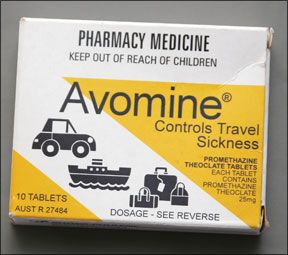
Only three of our respondents had tried Phenergan. All found it effective, and all experienced extreme drowsiness and other side effects. Not only did they not prefer it, the respondents advised others not to use it, except in suppository form as a last resort.
Bottom line: The potential side effects and complications make this drug less attractive than others available for casual seasickness treatment.
STUGERON
Sold over-the-counter for motion sickness in many countries-the UK, Canada, New Zealand, Bermuda, Mexico, and others-Stugeron (active ingredient cinnarizine) has never been approved by the US Food and Drug Administration, and so it is not available in the US.
However, 82 percent of our respondents had tried it, and of those, all but 4 percent found it effective. Thirty-five percent experienced mild side effects ranging from dry mouth to weird dreams. Of those who took medication, 64 percent listed Stugeron as their drug of choice, and 58 percent recommended it to others, making it the most recommended product in the survey by a landslide. Two charter skippers interviewed even recommended Stugeron to their charter guests. John Neale of sail training school Mahina Expeditions also recommends Stugeron as a preventative medication.
One drawback, however, is that it takes two to five hours to become effective, significantly longer than other antihistamine antiemetics. Several respondents recommended starting medication the night before leaving on passage to get the maximum benefit.
CATMAT found Stugeron as efficacious as Scopolamine with the only side effect being drowsiness, and it was the only drug rated for mild to severe motion.
In rare instances, elderly patients treated with high doses for prolonged periods have developed tardive dyskinisia or extrapyramidal disorders (tremor, disorientation, balance disorders), including Parkinsons syndrome (www.sopharma.com/ci
nnarizin.phtml). But when used for motion sickness, Stugeron is taken infrequently over a short period at a dose one-fifth of that used to treat balance disorders. (Editors Note: Be aware that the over-the-counter Stugeron sold in Mexico is meant to be used for balance disorders, so each tablet contains 75 milligrams of cinnarizine, five times the recommended dosage for motion sickness.)
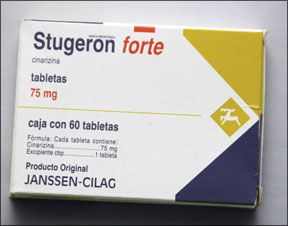
Bottom line: Based on our survey and medical evidence, Stugeron works in almost all sea conditions for almost all people with almost no short-term side effects. It was the drug of choice for nearly two-thirds of our respondents. However, the proven potential for serious long-term side effects cannot be ignored.
SCOPOLAMINE
This potent prescription drug, known generically as hyoscine, is an anticholinergic drug, but its effects are much stronger than most of the antihistamines. A central nervous system depressant, it works by depressing the action of the nerve fibers between the ear and the vomiting center of the brain. It can cause agitation, restlessness, and hallucinations in elderly patients, and trigger seizures and psychotic delusions in patients with a history of these problems.
Scopolamine is very effective (www.motionsickness.net/16article.html), but that potency comes at a much greater risk for side effects and more potential complications and drug interactions. Scopolamine is most commonly administered as a patch, but it is available in pill form.
TRANSDERM SCOP
Transderm Scop, or “the patch” as most sailors call it, is placed behind the ear and delivers a constant low dosage of scopolamine through the skin (about 1 milligram over 72 hours). It takes six to eight hours to become effective, so it must be applied well before travel.
The manufacturer removed it from the market in 1994 because of manufacturing problems. There had been reported incidents involving serious side effects when the patch had been torn in half to reduce the dosage. The re-formulated patch was introduced in 1998 with specific warnings against cutting it in half.
Of our respondents, 43 percent had tried the patch. Of those, only 8 percent found it ineffective, but 100 percent suffered side effects that ranged from severe dry mouth to visual difficulties, balance problems, hallucinations, and an inability to be woken up. None of our respondents preferred the current Transderm Scop, and none recommended it. However, two of the charter skippers we interviewed carried it aboard and used it on passengers incapacitated by seasickness for 24 hours and at risk of becoming dehydrated. It never failed to stop the vomiting within a few hours, they reported.
According to the CATMAT study: “It can cause confusional states and/or visual hallucinations, particularly in elderly individuals.” Upon discontinuing use, users reported such side effects as dizziness, nausea, vomiting, headache, and balance problems. These symptoms usually do not appear until 24 hours or more after the patch has been removed.
Bottom line:Studies have shown that Transderm Scop is among the most effective drugs on the market, but its possible side effects were not acceptable to our respondents. Those with truly debilitating symptoms who can find no other solution may want to try the patch, but for most, the cure seems to be worse than the disease. It can be relied on to stop vomiting in an emergency situation and is easier to administer than a suppository.
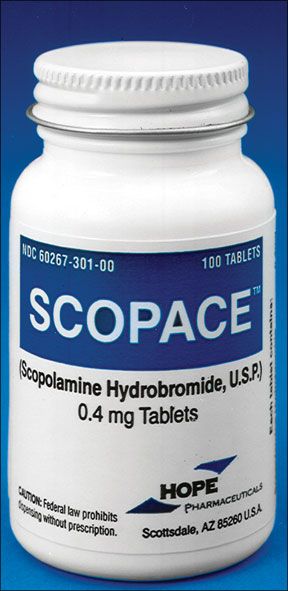
SCOPACE
The oral form of scopolamine, Scopolamine Hydrobromide, marketed as Scopace, has the same active ingredient as the patch, so its potential side effects, interactions, and complications are the same. However, in the pill form, the dosage can be modified to better suit the individual.
Only one respondent, who had a long history of debilitating seasickness, had taken this medication. After Dramamine and Stugeron proved ineffective, she switched to Scopace (0.4 milligrams every eight hours) and reported that she “could not cruise without it.”
Bottom line: Unlike the patch, Scopace allows users to tailor the dosage to their needs and may offer relief to those who suffer from debilitating seasickness that does not respond to the antihistamine antiemetics.
OTHER DRUGS
Two other drugs were mentioned in the survey, though no one had actually used them: Compazine (generic name: prochlorperazine) and Reglan (generic name, metoclopramide hydrochloride). Both are strong dopamine antagonistic antiemetics that may cause serious side effects at low dosages, including Parkinsons symptoms and tardive dyskinesia. Reglan can also cause depression.
Like Phenergan, Compazine once was regularly prescribed for motion sickness, but today, it is used to treat schizophrenia and nausea. Mahina Expeditions Neale reported that Compazine is a very effective treatment once seasickness has set in. It also treats anxiety, which can lead to seasickness, he said.
Reglan is used to treat serious digestive disorders. Both Compazine and Reglan are sometimes prescribed as antiemetics after surgery or chemotherapy.
Compazine is available as a suppository, and two of our respondents carried it aboard for emergency use. No one carried Reglan, but it was mentioned as a “new” antiemetic sailors might try. Neither is appropriate for regular use against seasickness.
CONCLUSION
Unlike with most test products, Practical Sailor cannot tell you which seasickness remedy to use. The efficacy and side effects vary too much from person to person, and the potential complications and drug interactions could be life threatening. Yet, our survey and a review of the medical literature do allow us to draw some conclusions.
The medication you should take is the one that works the best for you with the least side effects and risk of complications. Its always a good idea to take a test dose of a medication on land, before leaving on a passage, to determine its side effects on you.
Our survey respondents were clearly trying to balance efficacy against side effects. In this tradeoff, Bonine (meclizine) sits at one end of the spectrum with no serious side effects, but it is not effective for many people. Phenergan, Compazine, and Reglan sit at the other end (very effective but with many possible side effects). Transderm-Scop works most of the time in most people, as shown by our survey results and research; respondents preferred the scopolamine pill to the patch. The drowsiness caused by Dramamine precluded keeping a proper watch, so none of our respondents recommended it. The other antihistamine solutions, Marezine and Stugeron, offer a balance between efficacy and side effects that most of our respondents found acceptable, though they are by no means a panacea.
Based solely on the numbers, Stugeron would be the handsdown survey winner, but there are two drawbacks: It is not available in the US, and although fewer respondents reported side effects, studies show there is the potential for serious extrapyramidal effects with long-term use at high dosages in elderly people. The decision to use Stugeron to prevent seasickness must include weighing these factors and your degree of risk against Stugerons proven efficacy.
Few of the sailors interviewed had discovered Marezine or Scopace. Marezine is available in the US without a prescription, though it is rarely stocked. Based on our referenced medical studies and a very small sample size in our survey, Marezine appears to combine the efficacy of Stugeron with Bonines lack of side effects. Scopace may offer a solution for those who suffer debilitating seasickness and do not respond to the antihistamine antiemetics.
The goal is to find the best balance between efficacy and side effects for you. Be sure to involve your physician in the decision, especially if you try prescription drugs or have any condition listed as a complication.










